Reflection on Cultural Awareness: Experiences and Theories
VerifiedAdded on 2020/05/11
|9
|2037
|91
Essay
AI Summary
This essay provides a reflection on cultural awareness, drawing on the author's personal experiences during an internship at an Australian firm and interactions with individuals from diverse cultural backgrounds. The author discusses the challenges of navigating cultural differences in the workplace, including differing communication styles, workplace norms, and potential biases. The essay incorporates insights from intercultural communication theories, emphasizing the importance of open-mindedness, adaptability, and cultural sensitivity. The author analyzes instances of cultural misunderstandings and preconceptions, highlighting the need for effective communication, self-awareness, and respect for diverse cultural traditions. The essay also examines the experiences of a friend facing cultural bias and the importance of responding with understanding and pride. Through these reflections, the author emphasizes the significance of developing intercultural communication skills, promoting workplace harmony, and fostering stronger relationships among individuals from different cultural backgrounds. The essay concludes by analyzing a conversation with a friend's father, demonstrating the impact of cultural preconceptions and the need for sensitivity and respect in cross-cultural interactions.
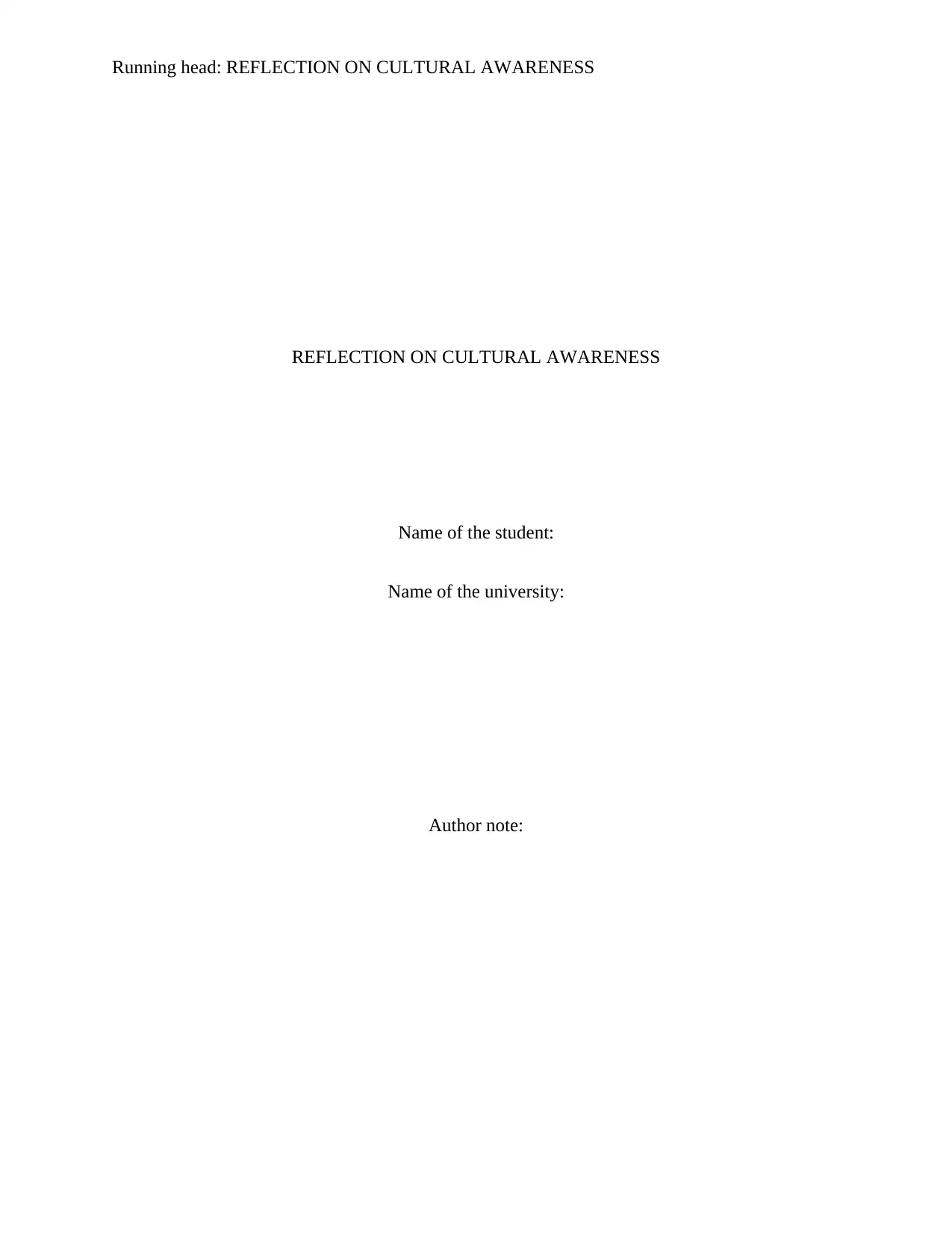
Running head: REFLECTION ON CULTURAL AWARENESS
REFLECTION ON CULTURAL AWARENESS
Name of the student:
Name of the university:
Author note:
REFLECTION ON CULTURAL AWARENESS
Name of the student:
Name of the university:
Author note:
Paraphrase This Document
Need a fresh take? Get an instant paraphrase of this document with our AI Paraphraser
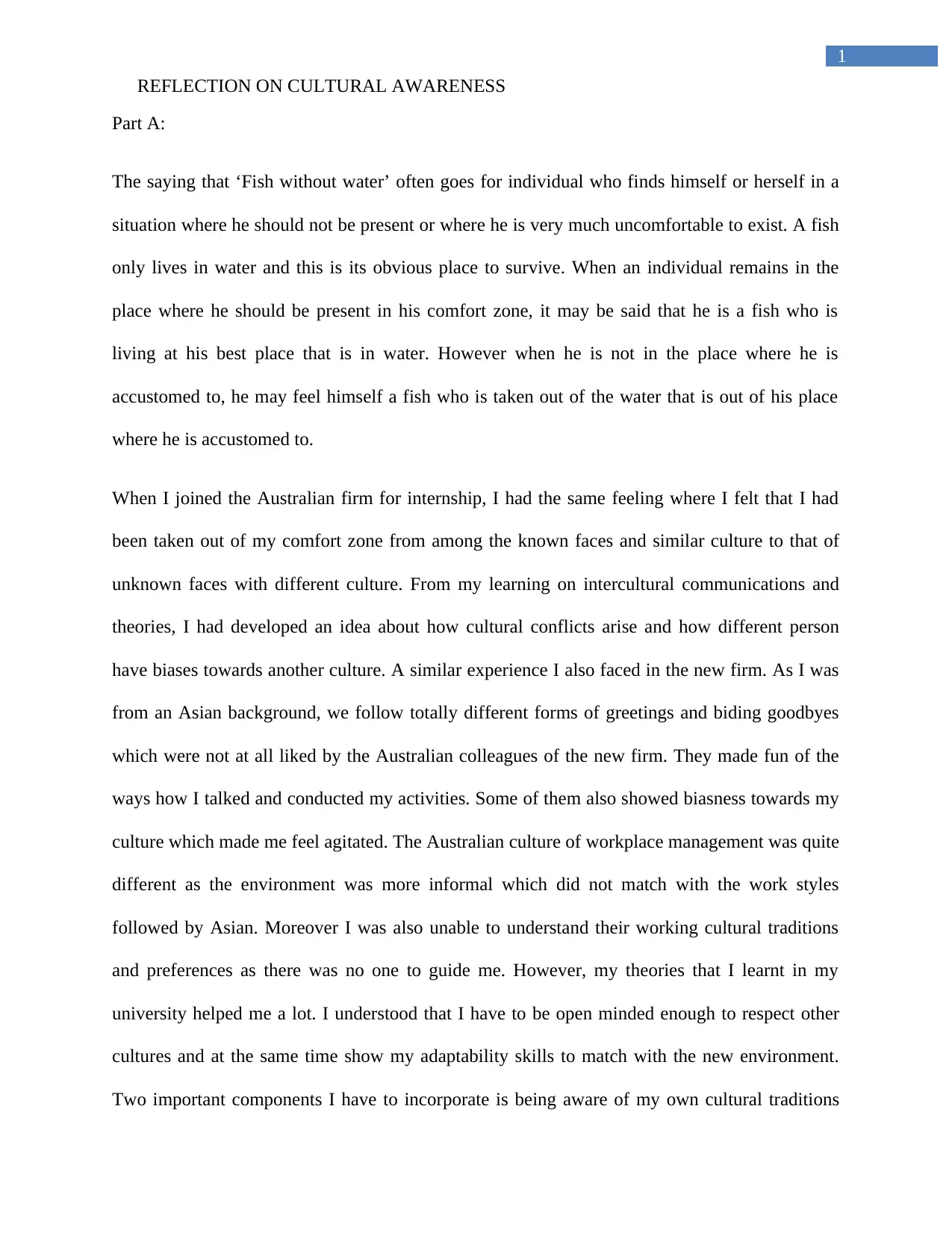
1
REFLECTION ON CULTURAL AWARENESS
Part A:
The saying that ‘Fish without water’ often goes for individual who finds himself or herself in a
situation where he should not be present or where he is very much uncomfortable to exist. A fish
only lives in water and this is its obvious place to survive. When an individual remains in the
place where he should be present in his comfort zone, it may be said that he is a fish who is
living at his best place that is in water. However when he is not in the place where he is
accustomed to, he may feel himself a fish who is taken out of the water that is out of his place
where he is accustomed to.
When I joined the Australian firm for internship, I had the same feeling where I felt that I had
been taken out of my comfort zone from among the known faces and similar culture to that of
unknown faces with different culture. From my learning on intercultural communications and
theories, I had developed an idea about how cultural conflicts arise and how different person
have biases towards another culture. A similar experience I also faced in the new firm. As I was
from an Asian background, we follow totally different forms of greetings and biding goodbyes
which were not at all liked by the Australian colleagues of the new firm. They made fun of the
ways how I talked and conducted my activities. Some of them also showed biasness towards my
culture which made me feel agitated. The Australian culture of workplace management was quite
different as the environment was more informal which did not match with the work styles
followed by Asian. Moreover I was also unable to understand their working cultural traditions
and preferences as there was no one to guide me. However, my theories that I learnt in my
university helped me a lot. I understood that I have to be open minded enough to respect other
cultures and at the same time show my adaptability skills to match with the new environment.
Two important components I have to incorporate is being aware of my own cultural traditions
REFLECTION ON CULTURAL AWARENESS
Part A:
The saying that ‘Fish without water’ often goes for individual who finds himself or herself in a
situation where he should not be present or where he is very much uncomfortable to exist. A fish
only lives in water and this is its obvious place to survive. When an individual remains in the
place where he should be present in his comfort zone, it may be said that he is a fish who is
living at his best place that is in water. However when he is not in the place where he is
accustomed to, he may feel himself a fish who is taken out of the water that is out of his place
where he is accustomed to.
When I joined the Australian firm for internship, I had the same feeling where I felt that I had
been taken out of my comfort zone from among the known faces and similar culture to that of
unknown faces with different culture. From my learning on intercultural communications and
theories, I had developed an idea about how cultural conflicts arise and how different person
have biases towards another culture. A similar experience I also faced in the new firm. As I was
from an Asian background, we follow totally different forms of greetings and biding goodbyes
which were not at all liked by the Australian colleagues of the new firm. They made fun of the
ways how I talked and conducted my activities. Some of them also showed biasness towards my
culture which made me feel agitated. The Australian culture of workplace management was quite
different as the environment was more informal which did not match with the work styles
followed by Asian. Moreover I was also unable to understand their working cultural traditions
and preferences as there was no one to guide me. However, my theories that I learnt in my
university helped me a lot. I understood that I have to be open minded enough to respect other
cultures and at the same time show my adaptability skills to match with the new environment.
Two important components I have to incorporate is being aware of my own cultural traditions
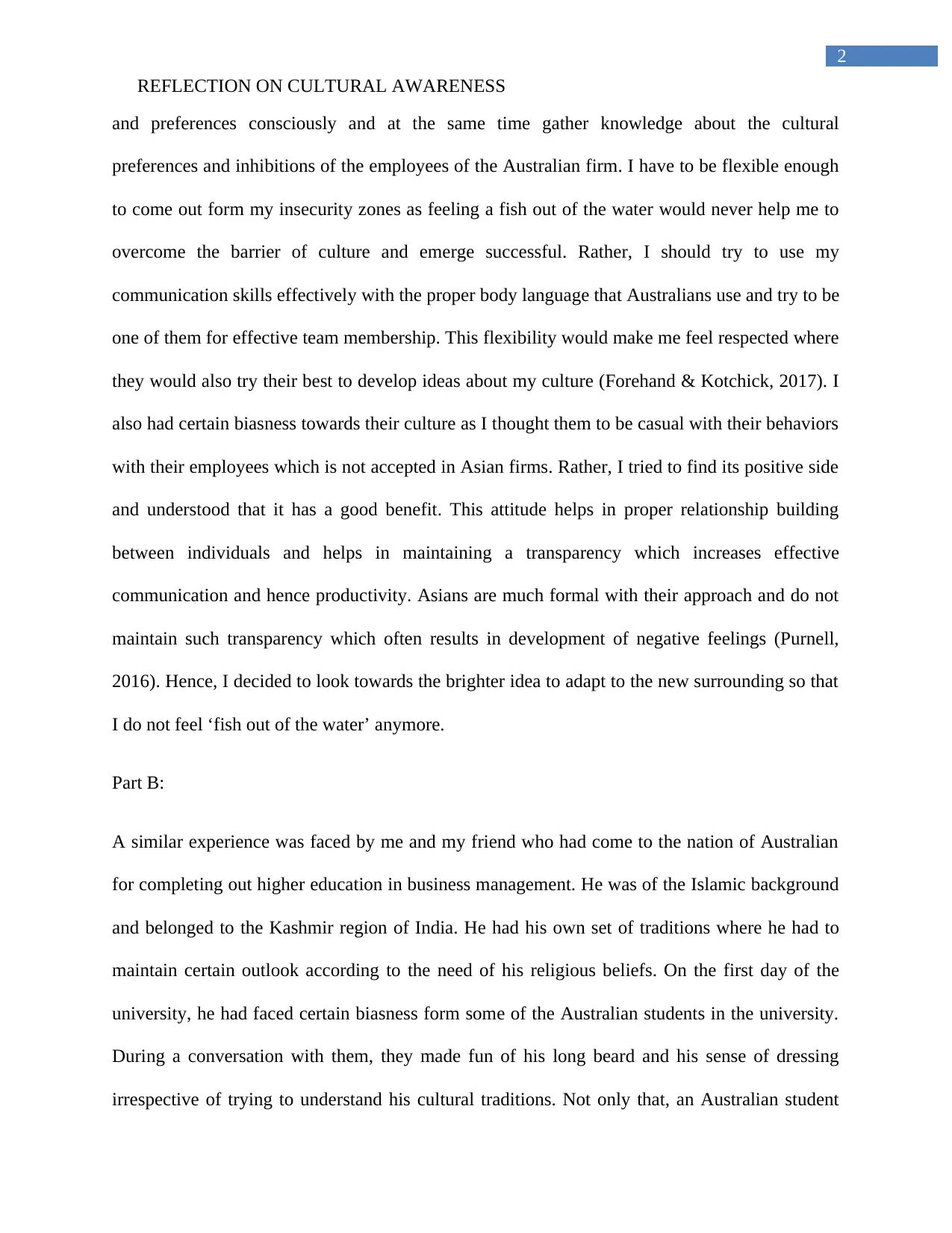
2
REFLECTION ON CULTURAL AWARENESS
and preferences consciously and at the same time gather knowledge about the cultural
preferences and inhibitions of the employees of the Australian firm. I have to be flexible enough
to come out form my insecurity zones as feeling a fish out of the water would never help me to
overcome the barrier of culture and emerge successful. Rather, I should try to use my
communication skills effectively with the proper body language that Australians use and try to be
one of them for effective team membership. This flexibility would make me feel respected where
they would also try their best to develop ideas about my culture (Forehand & Kotchick, 2017). I
also had certain biasness towards their culture as I thought them to be casual with their behaviors
with their employees which is not accepted in Asian firms. Rather, I tried to find its positive side
and understood that it has a good benefit. This attitude helps in proper relationship building
between individuals and helps in maintaining a transparency which increases effective
communication and hence productivity. Asians are much formal with their approach and do not
maintain such transparency which often results in development of negative feelings (Purnell,
2016). Hence, I decided to look towards the brighter idea to adapt to the new surrounding so that
I do not feel ‘fish out of the water’ anymore.
Part B:
A similar experience was faced by me and my friend who had come to the nation of Australian
for completing out higher education in business management. He was of the Islamic background
and belonged to the Kashmir region of India. He had his own set of traditions where he had to
maintain certain outlook according to the need of his religious beliefs. On the first day of the
university, he had faced certain biasness form some of the Australian students in the university.
During a conversation with them, they made fun of his long beard and his sense of dressing
irrespective of trying to understand his cultural traditions. Not only that, an Australian student
REFLECTION ON CULTURAL AWARENESS
and preferences consciously and at the same time gather knowledge about the cultural
preferences and inhibitions of the employees of the Australian firm. I have to be flexible enough
to come out form my insecurity zones as feeling a fish out of the water would never help me to
overcome the barrier of culture and emerge successful. Rather, I should try to use my
communication skills effectively with the proper body language that Australians use and try to be
one of them for effective team membership. This flexibility would make me feel respected where
they would also try their best to develop ideas about my culture (Forehand & Kotchick, 2017). I
also had certain biasness towards their culture as I thought them to be casual with their behaviors
with their employees which is not accepted in Asian firms. Rather, I tried to find its positive side
and understood that it has a good benefit. This attitude helps in proper relationship building
between individuals and helps in maintaining a transparency which increases effective
communication and hence productivity. Asians are much formal with their approach and do not
maintain such transparency which often results in development of negative feelings (Purnell,
2016). Hence, I decided to look towards the brighter idea to adapt to the new surrounding so that
I do not feel ‘fish out of the water’ anymore.
Part B:
A similar experience was faced by me and my friend who had come to the nation of Australian
for completing out higher education in business management. He was of the Islamic background
and belonged to the Kashmir region of India. He had his own set of traditions where he had to
maintain certain outlook according to the need of his religious beliefs. On the first day of the
university, he had faced certain biasness form some of the Australian students in the university.
During a conversation with them, they made fun of his long beard and his sense of dressing
irrespective of trying to understand his cultural traditions. Not only that, an Australian student
⊘ This is a preview!⊘
Do you want full access?
Subscribe today to unlock all pages.

Trusted by 1+ million students worldwide
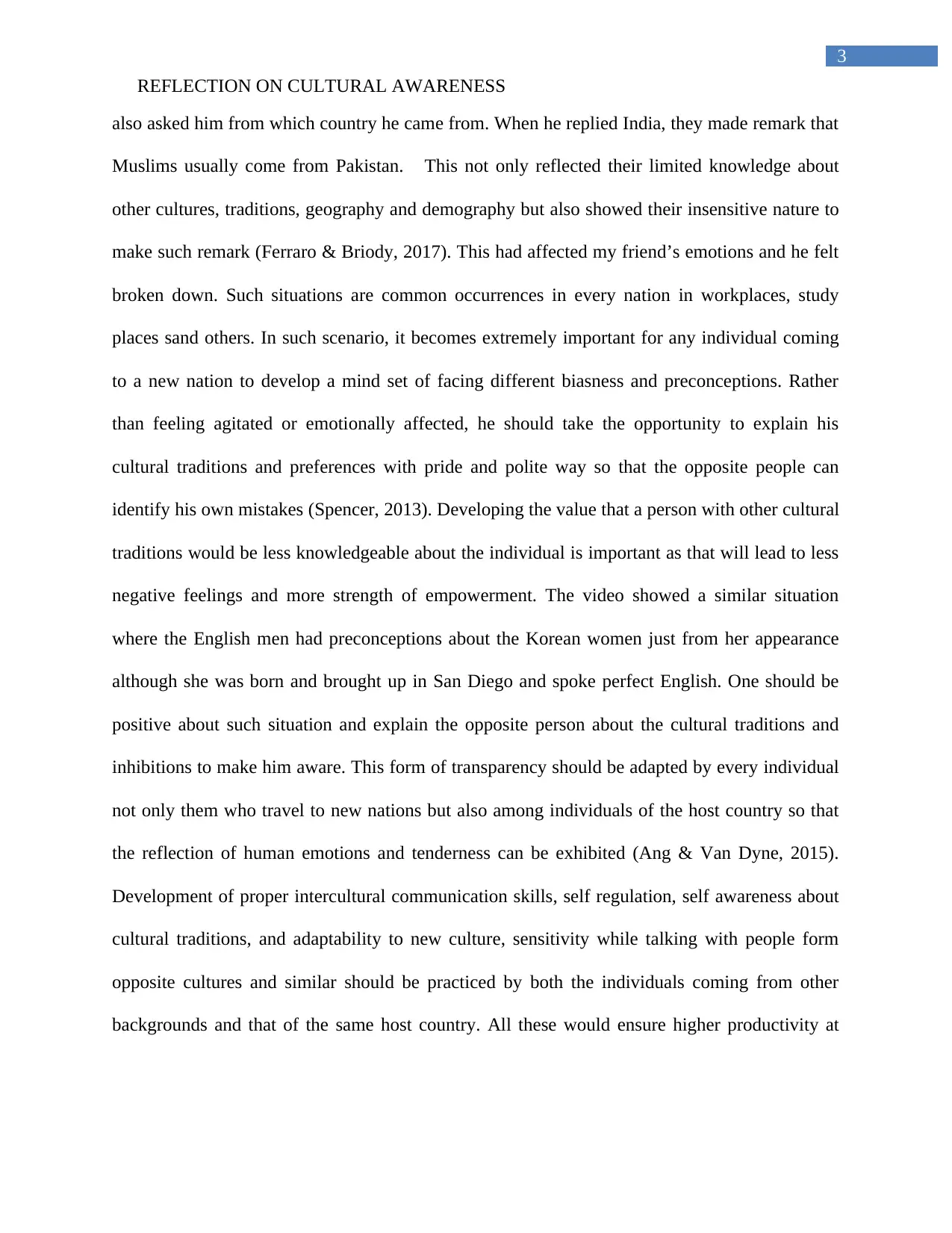
3
REFLECTION ON CULTURAL AWARENESS
also asked him from which country he came from. When he replied India, they made remark that
Muslims usually come from Pakistan. This not only reflected their limited knowledge about
other cultures, traditions, geography and demography but also showed their insensitive nature to
make such remark (Ferraro & Briody, 2017). This had affected my friend’s emotions and he felt
broken down. Such situations are common occurrences in every nation in workplaces, study
places sand others. In such scenario, it becomes extremely important for any individual coming
to a new nation to develop a mind set of facing different biasness and preconceptions. Rather
than feeling agitated or emotionally affected, he should take the opportunity to explain his
cultural traditions and preferences with pride and polite way so that the opposite people can
identify his own mistakes (Spencer, 2013). Developing the value that a person with other cultural
traditions would be less knowledgeable about the individual is important as that will lead to less
negative feelings and more strength of empowerment. The video showed a similar situation
where the English men had preconceptions about the Korean women just from her appearance
although she was born and brought up in San Diego and spoke perfect English. One should be
positive about such situation and explain the opposite person about the cultural traditions and
inhibitions to make him aware. This form of transparency should be adapted by every individual
not only them who travel to new nations but also among individuals of the host country so that
the reflection of human emotions and tenderness can be exhibited (Ang & Van Dyne, 2015).
Development of proper intercultural communication skills, self regulation, self awareness about
cultural traditions, and adaptability to new culture, sensitivity while talking with people form
opposite cultures and similar should be practiced by both the individuals coming from other
backgrounds and that of the same host country. All these would ensure higher productivity at
REFLECTION ON CULTURAL AWARENESS
also asked him from which country he came from. When he replied India, they made remark that
Muslims usually come from Pakistan. This not only reflected their limited knowledge about
other cultures, traditions, geography and demography but also showed their insensitive nature to
make such remark (Ferraro & Briody, 2017). This had affected my friend’s emotions and he felt
broken down. Such situations are common occurrences in every nation in workplaces, study
places sand others. In such scenario, it becomes extremely important for any individual coming
to a new nation to develop a mind set of facing different biasness and preconceptions. Rather
than feeling agitated or emotionally affected, he should take the opportunity to explain his
cultural traditions and preferences with pride and polite way so that the opposite people can
identify his own mistakes (Spencer, 2013). Developing the value that a person with other cultural
traditions would be less knowledgeable about the individual is important as that will lead to less
negative feelings and more strength of empowerment. The video showed a similar situation
where the English men had preconceptions about the Korean women just from her appearance
although she was born and brought up in San Diego and spoke perfect English. One should be
positive about such situation and explain the opposite person about the cultural traditions and
inhibitions to make him aware. This form of transparency should be adapted by every individual
not only them who travel to new nations but also among individuals of the host country so that
the reflection of human emotions and tenderness can be exhibited (Ang & Van Dyne, 2015).
Development of proper intercultural communication skills, self regulation, self awareness about
cultural traditions, and adaptability to new culture, sensitivity while talking with people form
opposite cultures and similar should be practiced by both the individuals coming from other
backgrounds and that of the same host country. All these would ensure higher productivity at
Paraphrase This Document
Need a fresh take? Get an instant paraphrase of this document with our AI Paraphraser
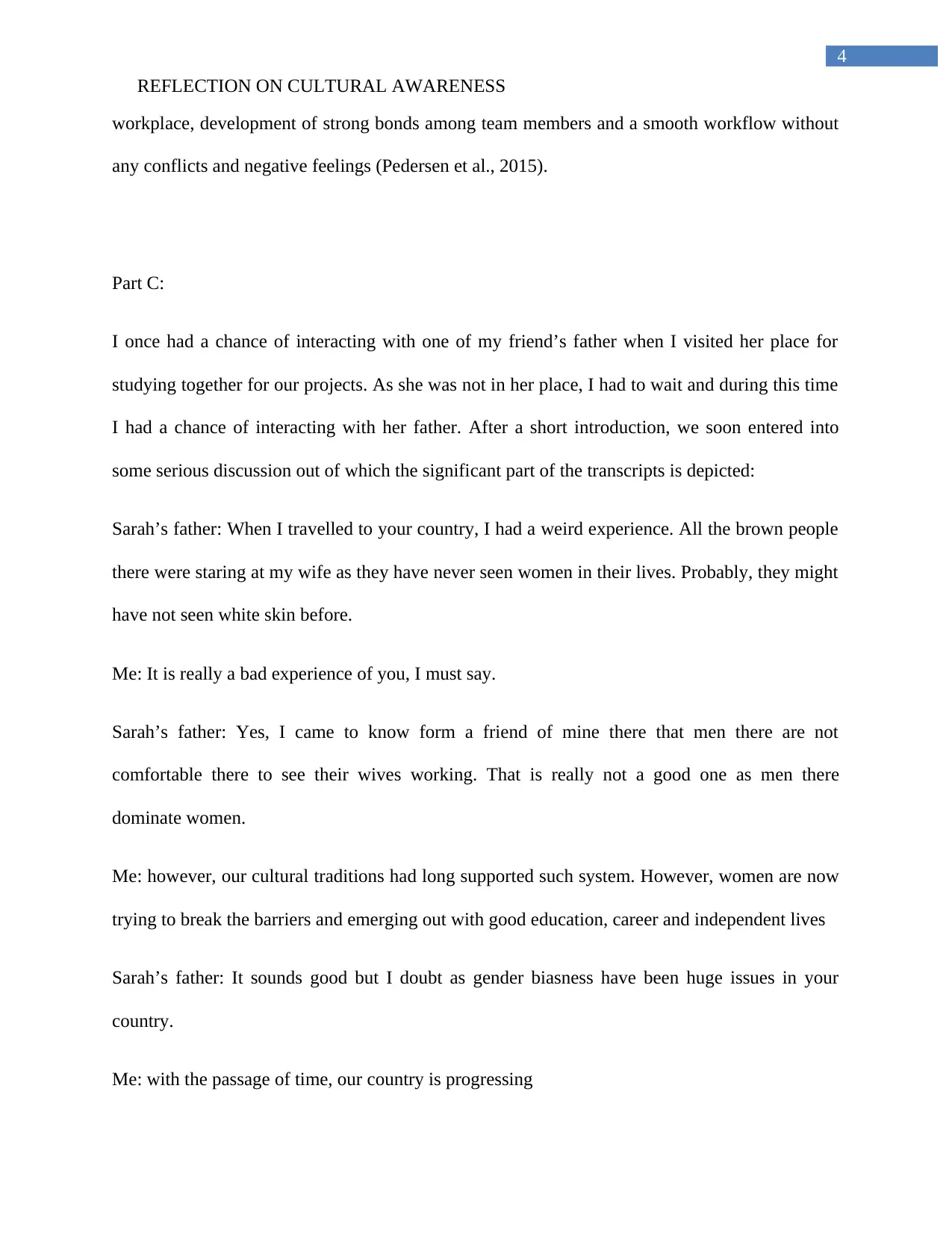
4
REFLECTION ON CULTURAL AWARENESS
workplace, development of strong bonds among team members and a smooth workflow without
any conflicts and negative feelings (Pedersen et al., 2015).
Part C:
I once had a chance of interacting with one of my friend’s father when I visited her place for
studying together for our projects. As she was not in her place, I had to wait and during this time
I had a chance of interacting with her father. After a short introduction, we soon entered into
some serious discussion out of which the significant part of the transcripts is depicted:
Sarah’s father: When I travelled to your country, I had a weird experience. All the brown people
there were staring at my wife as they have never seen women in their lives. Probably, they might
have not seen white skin before.
Me: It is really a bad experience of you, I must say.
Sarah’s father: Yes, I came to know form a friend of mine there that men there are not
comfortable there to see their wives working. That is really not a good one as men there
dominate women.
Me: however, our cultural traditions had long supported such system. However, women are now
trying to break the barriers and emerging out with good education, career and independent lives
Sarah’s father: It sounds good but I doubt as gender biasness have been huge issues in your
country.
Me: with the passage of time, our country is progressing
REFLECTION ON CULTURAL AWARENESS
workplace, development of strong bonds among team members and a smooth workflow without
any conflicts and negative feelings (Pedersen et al., 2015).
Part C:
I once had a chance of interacting with one of my friend’s father when I visited her place for
studying together for our projects. As she was not in her place, I had to wait and during this time
I had a chance of interacting with her father. After a short introduction, we soon entered into
some serious discussion out of which the significant part of the transcripts is depicted:
Sarah’s father: When I travelled to your country, I had a weird experience. All the brown people
there were staring at my wife as they have never seen women in their lives. Probably, they might
have not seen white skin before.
Me: It is really a bad experience of you, I must say.
Sarah’s father: Yes, I came to know form a friend of mine there that men there are not
comfortable there to see their wives working. That is really not a good one as men there
dominate women.
Me: however, our cultural traditions had long supported such system. However, women are now
trying to break the barriers and emerging out with good education, career and independent lives
Sarah’s father: It sounds good but I doubt as gender biasness have been huge issues in your
country.
Me: with the passage of time, our country is progressing
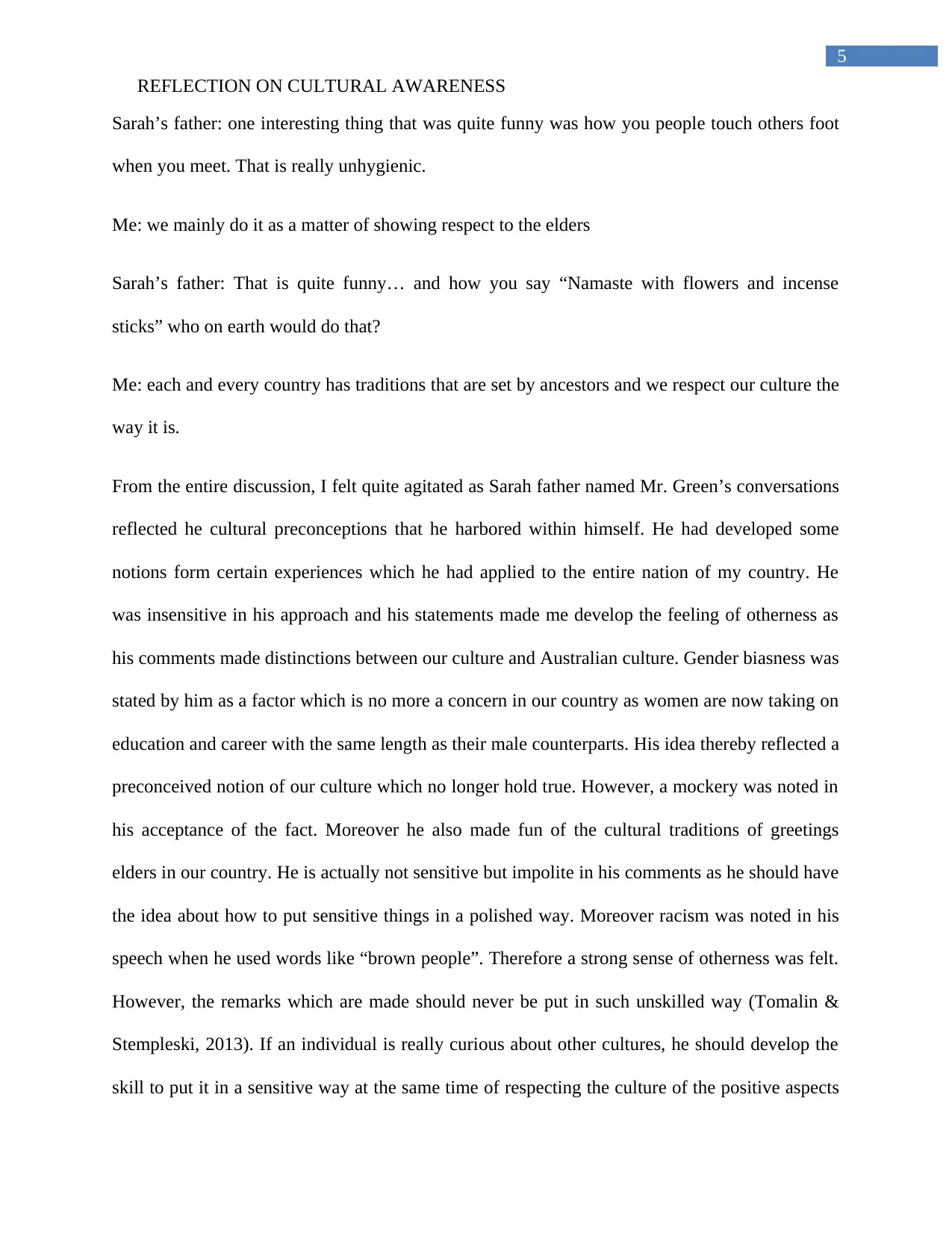
5
REFLECTION ON CULTURAL AWARENESS
Sarah’s father: one interesting thing that was quite funny was how you people touch others foot
when you meet. That is really unhygienic.
Me: we mainly do it as a matter of showing respect to the elders
Sarah’s father: That is quite funny… and how you say “Namaste with flowers and incense
sticks” who on earth would do that?
Me: each and every country has traditions that are set by ancestors and we respect our culture the
way it is.
From the entire discussion, I felt quite agitated as Sarah father named Mr. Green’s conversations
reflected he cultural preconceptions that he harbored within himself. He had developed some
notions form certain experiences which he had applied to the entire nation of my country. He
was insensitive in his approach and his statements made me develop the feeling of otherness as
his comments made distinctions between our culture and Australian culture. Gender biasness was
stated by him as a factor which is no more a concern in our country as women are now taking on
education and career with the same length as their male counterparts. His idea thereby reflected a
preconceived notion of our culture which no longer hold true. However, a mockery was noted in
his acceptance of the fact. Moreover he also made fun of the cultural traditions of greetings
elders in our country. He is actually not sensitive but impolite in his comments as he should have
the idea about how to put sensitive things in a polished way. Moreover racism was noted in his
speech when he used words like “brown people”. Therefore a strong sense of otherness was felt.
However, the remarks which are made should never be put in such unskilled way (Tomalin &
Stempleski, 2013). If an individual is really curious about other cultures, he should develop the
skill to put it in a sensitive way at the same time of respecting the culture of the positive aspects
REFLECTION ON CULTURAL AWARENESS
Sarah’s father: one interesting thing that was quite funny was how you people touch others foot
when you meet. That is really unhygienic.
Me: we mainly do it as a matter of showing respect to the elders
Sarah’s father: That is quite funny… and how you say “Namaste with flowers and incense
sticks” who on earth would do that?
Me: each and every country has traditions that are set by ancestors and we respect our culture the
way it is.
From the entire discussion, I felt quite agitated as Sarah father named Mr. Green’s conversations
reflected he cultural preconceptions that he harbored within himself. He had developed some
notions form certain experiences which he had applied to the entire nation of my country. He
was insensitive in his approach and his statements made me develop the feeling of otherness as
his comments made distinctions between our culture and Australian culture. Gender biasness was
stated by him as a factor which is no more a concern in our country as women are now taking on
education and career with the same length as their male counterparts. His idea thereby reflected a
preconceived notion of our culture which no longer hold true. However, a mockery was noted in
his acceptance of the fact. Moreover he also made fun of the cultural traditions of greetings
elders in our country. He is actually not sensitive but impolite in his comments as he should have
the idea about how to put sensitive things in a polished way. Moreover racism was noted in his
speech when he used words like “brown people”. Therefore a strong sense of otherness was felt.
However, the remarks which are made should never be put in such unskilled way (Tomalin &
Stempleski, 2013). If an individual is really curious about other cultures, he should develop the
skill to put it in a sensitive way at the same time of respecting the culture of the positive aspects
⊘ This is a preview!⊘
Do you want full access?
Subscribe today to unlock all pages.

Trusted by 1+ million students worldwide
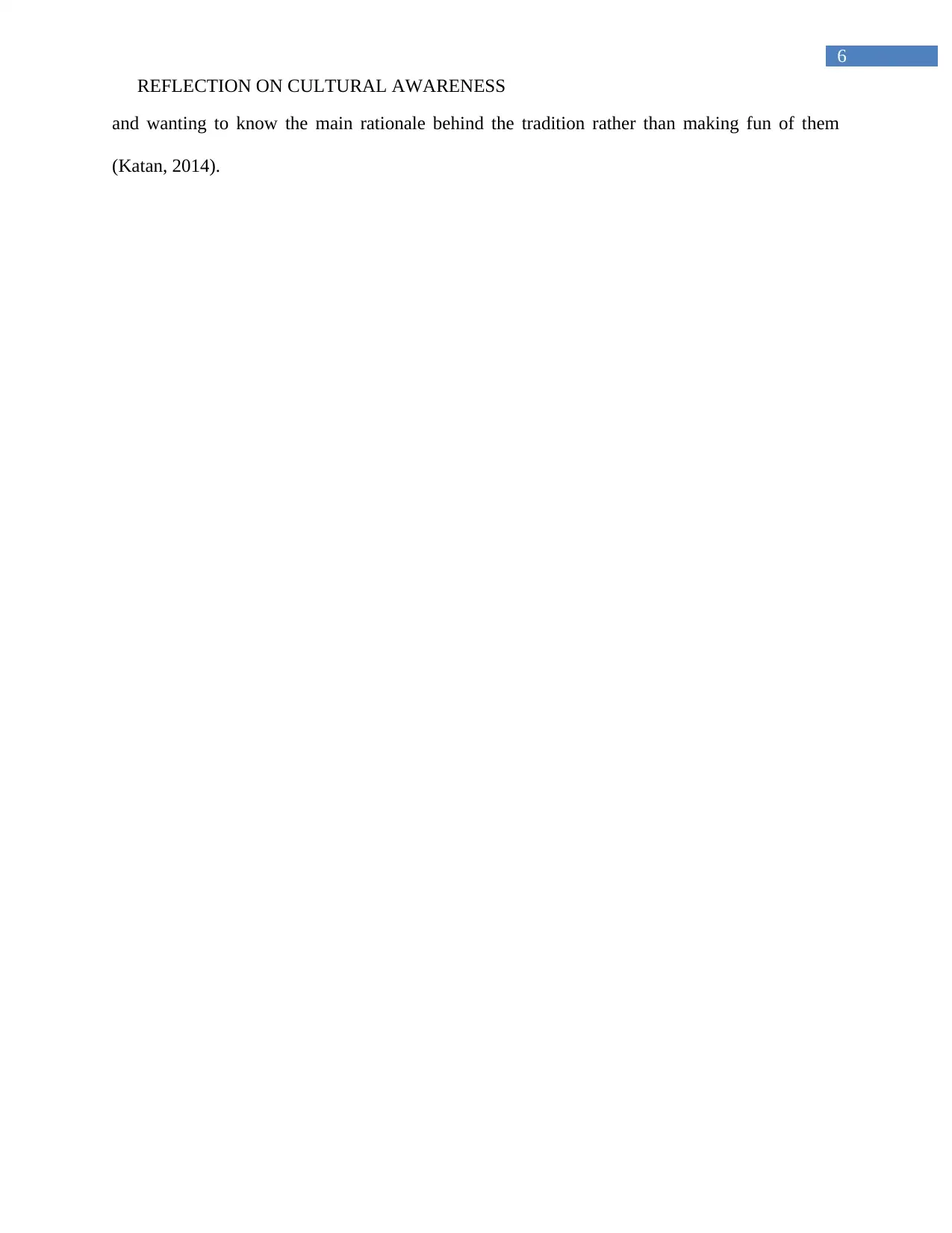
6
REFLECTION ON CULTURAL AWARENESS
and wanting to know the main rationale behind the tradition rather than making fun of them
(Katan, 2014).
REFLECTION ON CULTURAL AWARENESS
and wanting to know the main rationale behind the tradition rather than making fun of them
(Katan, 2014).
Paraphrase This Document
Need a fresh take? Get an instant paraphrase of this document with our AI Paraphraser
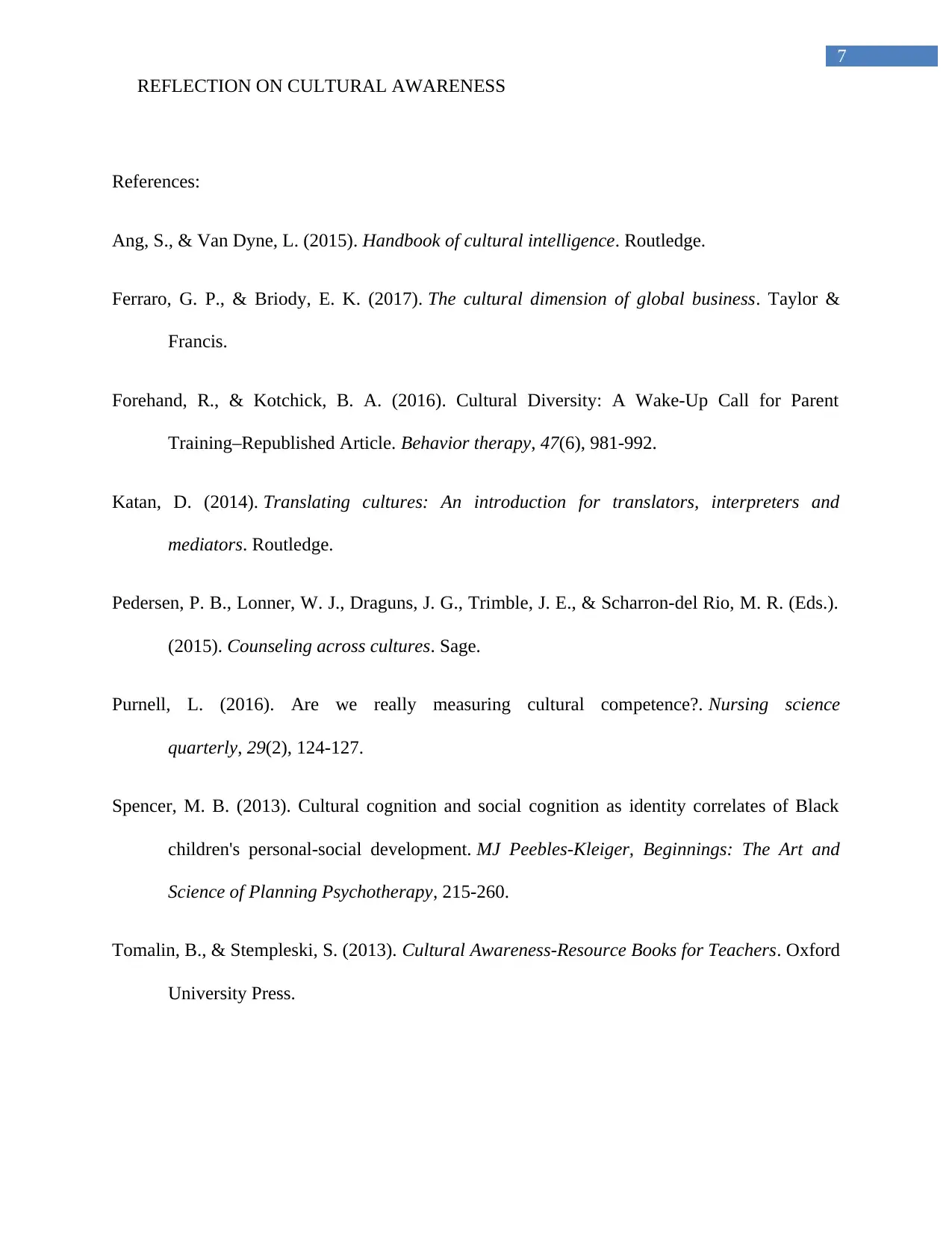
7
REFLECTION ON CULTURAL AWARENESS
References:
Ang, S., & Van Dyne, L. (2015). Handbook of cultural intelligence. Routledge.
Ferraro, G. P., & Briody, E. K. (2017). The cultural dimension of global business. Taylor &
Francis.
Forehand, R., & Kotchick, B. A. (2016). Cultural Diversity: A Wake-Up Call for Parent
Training–Republished Article. Behavior therapy, 47(6), 981-992.
Katan, D. (2014). Translating cultures: An introduction for translators, interpreters and
mediators. Routledge.
Pedersen, P. B., Lonner, W. J., Draguns, J. G., Trimble, J. E., & Scharron-del Rio, M. R. (Eds.).
(2015). Counseling across cultures. Sage.
Purnell, L. (2016). Are we really measuring cultural competence?. Nursing science
quarterly, 29(2), 124-127.
Spencer, M. B. (2013). Cultural cognition and social cognition as identity correlates of Black
children's personal-social development. MJ Peebles-Kleiger, Beginnings: The Art and
Science of Planning Psychotherapy, 215-260.
Tomalin, B., & Stempleski, S. (2013). Cultural Awareness-Resource Books for Teachers. Oxford
University Press.
REFLECTION ON CULTURAL AWARENESS
References:
Ang, S., & Van Dyne, L. (2015). Handbook of cultural intelligence. Routledge.
Ferraro, G. P., & Briody, E. K. (2017). The cultural dimension of global business. Taylor &
Francis.
Forehand, R., & Kotchick, B. A. (2016). Cultural Diversity: A Wake-Up Call for Parent
Training–Republished Article. Behavior therapy, 47(6), 981-992.
Katan, D. (2014). Translating cultures: An introduction for translators, interpreters and
mediators. Routledge.
Pedersen, P. B., Lonner, W. J., Draguns, J. G., Trimble, J. E., & Scharron-del Rio, M. R. (Eds.).
(2015). Counseling across cultures. Sage.
Purnell, L. (2016). Are we really measuring cultural competence?. Nursing science
quarterly, 29(2), 124-127.
Spencer, M. B. (2013). Cultural cognition and social cognition as identity correlates of Black
children's personal-social development. MJ Peebles-Kleiger, Beginnings: The Art and
Science of Planning Psychotherapy, 215-260.
Tomalin, B., & Stempleski, S. (2013). Cultural Awareness-Resource Books for Teachers. Oxford
University Press.

8
REFLECTION ON CULTURAL AWARENESS
REFLECTION ON CULTURAL AWARENESS
⊘ This is a preview!⊘
Do you want full access?
Subscribe today to unlock all pages.

Trusted by 1+ million students worldwide
1 out of 9
Related Documents
Your All-in-One AI-Powered Toolkit for Academic Success.
+13062052269
info@desklib.com
Available 24*7 on WhatsApp / Email
![[object Object]](/_next/static/media/star-bottom.7253800d.svg)
Unlock your academic potential
Copyright © 2020–2025 A2Z Services. All Rights Reserved. Developed and managed by ZUCOL.





